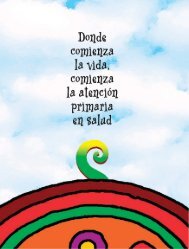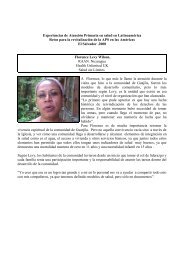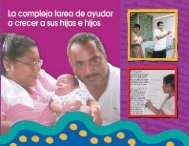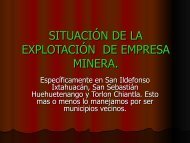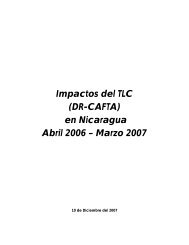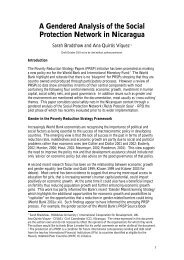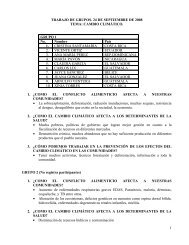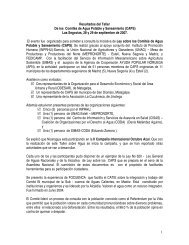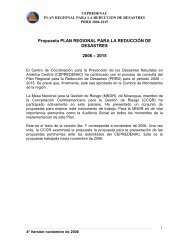Download - CISAS | Centro de Información y Servicios de AsesorÃa ...
Download - CISAS | Centro de Información y Servicios de AsesorÃa ...
Download - CISAS | Centro de Información y Servicios de AsesorÃa ...
Create successful ePaper yourself
Turn your PDF publications into a flip-book with our unique Google optimized e-Paper software.
INFORME ALTERNATIVO SOBRE LA SALUD EN AMERICA LATINASince 1992, according to law, petroleum companiesmust monitor regularly the levels of environmentalcontamination and send the corresponding reportsto the national Government of Ecuador. This informationis not accessible to public opinion. However,when one of these reports was presented in 1999 toa community that had constantly complained to theDepartment of Environment for the environmentalcontamination by petroleum, concentrations of petroleumtotal hydrocarbons superior by 500 times to thelimit permitted by the regulation of the EuropeanUnion were found in the rivers of the mentioned community.The petroleum company and the representativeof the Ecuadorian Government maintained thatthe levels of petroleum total hydrocarbons were normal[Ecuador. Ministerio <strong>de</strong> Medio Ambiente, 1999].Within the Amazonian Region of Ecuador thedata available on the contamination of soil and its possibleimpact is scarce, and not one study has been doneon the impact that petroleum <strong>de</strong>velopment has onboth fish and fishing. Nevertheless, studies of theAmazonian Region in Peru found high concentrationsof petroleum total hydrocarbons in the stomach andmuscles of fish after an overflow of petroleum in theriver Marañón [Perú. Dirección Regional <strong>de</strong> Pesquería<strong>de</strong> Loreto, 2000].Effects in HealthFor several years, the resi<strong>de</strong>nts in areas of petroleumexploitation in the Amazonian Region in Ecuadorhave expressed their concerns in relation to contaminationcoming from the exploitation. Many indigenousand peasant communities have <strong>de</strong>clared that numerouslocal rivers and streams, which used to be plentifulfor fishing, at present lack aquatic life.They have observed,as well, how cattle die after drinking the waterof those rivers and streams. These are the same watersthat population customarily utilizes to drink,cook, and bathe. The resi<strong>de</strong>nts of these areas have alsostated that bathing in these rivers produces skinirritation, especially after intense rain, as this acceleratesthe flux of waste from the pools near the rivers[Kimerling, 1991; Kimerling, 1995].In 1993, an association of health promoters forthe Amazon accomplished a study that <strong>de</strong>scribed thecommunities. The study found that communities inareas of petroleum exploitation had elevated rates ofmorbidity, with notably prevailing abortions, <strong>de</strong>rmatitis,skin fungus, and malnutrition, as well as a majormortality rate compared to communities where therewas no petroleum exploitation [Unión <strong>de</strong> PromotoresPopulares <strong>de</strong> Salud <strong>de</strong> la Amazonía Ecuatoriana, 1993].In 1997, the Institute of Epi<strong>de</strong>miology and CommunitarianHealth "Manuel Amunárriz" initiated a researchprocess to evaluate the possible impact onhealth, of the contamination by petroleum in communitiesnear the oil fields. Through the first of these studies,women who lived in communities near oil fieldsshowed greater rates of diverse symptoms (skin mycoses,fatigue, irritation in the nose and/or the eyes,sore throat, headache, earache, diarrhea, and gastritis)than women who lived in communities without petroleumexploitation [San Sebastián,Armstrong, Stephens,2001]. In addition, it was <strong>de</strong>tected that the risk ofspontaneous abortions was 2,5 times greater in womenwho lived in the vicinity of the oil fields [San Sebastián,Armstrong, Stephens, 2002]. The research in1998 of a cluster of cancers in a community situatedin an area of petroleum exploitation in the AmazonianRegion of Ecuador uncovered an excess of cancersamong the masculine population [San Sebastián,Armstrong,Cordoba, Stephens, 2001]. In 2000, anotherstudy investigated the differences in the inci<strong>de</strong>nce ofcancer from 1985 to 1998 in the Amazonian Region ofEcuador. This study revealed an inci<strong>de</strong>nce of cancersignificantly greater, as much in women as in men wit-180



